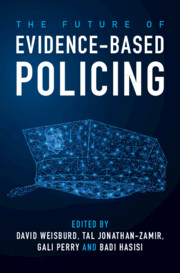Book contents
- The Future of Evidence-Based Policing
- The Future of Evidence-Based Policing
- Copyright page
- Contents
- Figures
- Tables
- Contributors
- Editors
- 1 The Future of Evidence-Based Policing
- Part I Taking Stock of Evidence-Based Policing
- Part II The Evidence for Evidence-Based Policing
- Part III Innovations in Tools of Evaluation and Assessment
- Part IV Challenges to the Implementation of Evidence-Based Policing
- 10 Practitioners’ Inclination to Rely on Experience
- 11 Implementing Evidence-Based Policing
- 12 Towards Implementing Evidence-Based Policing
- 13 Evidence-Based Policing and the Law
- Part V The Practitioner’s Perspective
- 17 Conclusions
- Index
- References
11 - Implementing Evidence-Based Policing
Findings from a Process Evaluation of the EMUN Reform in the Israel Police
from Part IV - Challenges to the Implementation of Evidence-Based Policing
Published online by Cambridge University Press: 01 June 2023
- The Future of Evidence-Based Policing
- The Future of Evidence-Based Policing
- Copyright page
- Contents
- Figures
- Tables
- Contributors
- Editors
- 1 The Future of Evidence-Based Policing
- Part I Taking Stock of Evidence-Based Policing
- Part II The Evidence for Evidence-Based Policing
- Part III Innovations in Tools of Evaluation and Assessment
- Part IV Challenges to the Implementation of Evidence-Based Policing
- 10 Practitioners’ Inclination to Rely on Experience
- 11 Implementing Evidence-Based Policing
- 12 Towards Implementing Evidence-Based Policing
- 13 Evidence-Based Policing and the Law
- Part V The Practitioner’s Perspective
- 17 Conclusions
- Index
- References
Summary
Evidence-based policing requires not only the production of high-quality research but also the implementation of those research findings as part of a police organization’s work. To date, there has been relatively limited empirical assessment of how to best achieve successful implementation. This chapter presents findings from the process evaluation of the EMUN reform in the Israel Police. The reform institutionalized several evidence-based policing approaches and has been demonstrated as effective in reducing and preventing crime. Our qualitative analysis uncovered three themes associated with a heightened capability to practice evidence-based policing: the ability to analyze data and reflect on it, organizational flexibility, and local engagement with the reform. These themes resonate with the existing literature in the field and are of broad relevance.
- Type
- Chapter
- Information
- The Future of Evidence-Based Policing , pp. 211 - 234Publisher: Cambridge University PressPrint publication year: 2023
References
- 1
- Cited by

